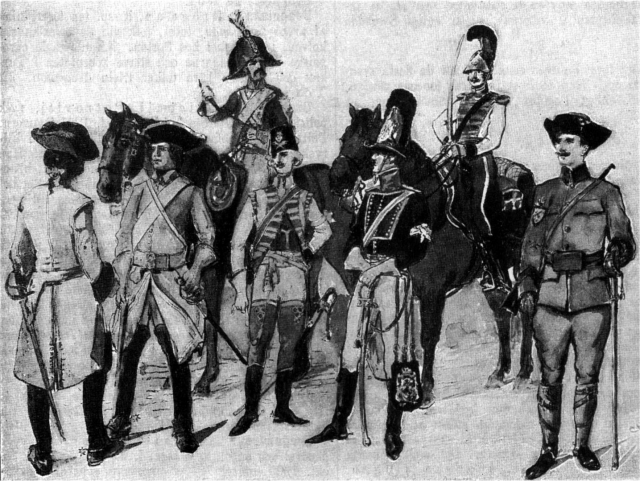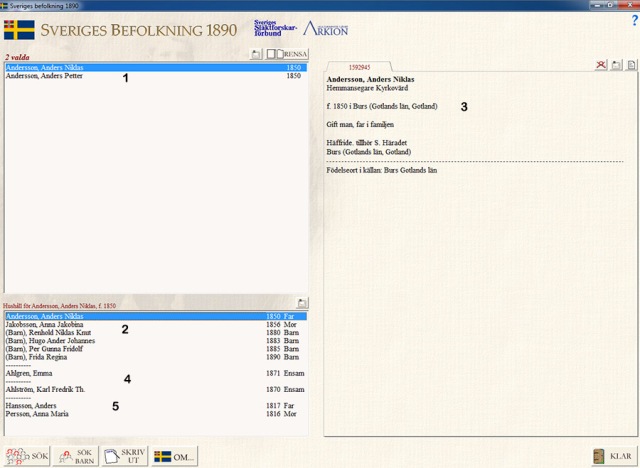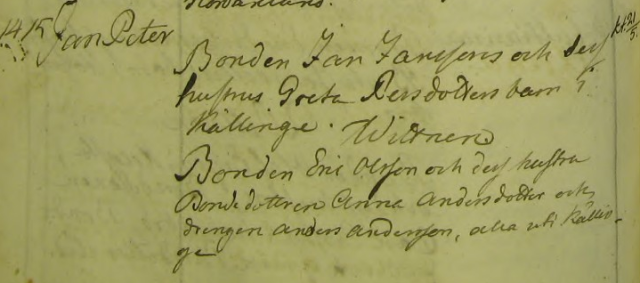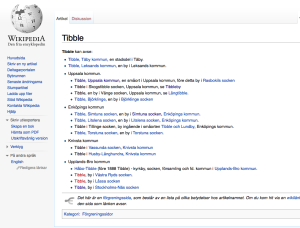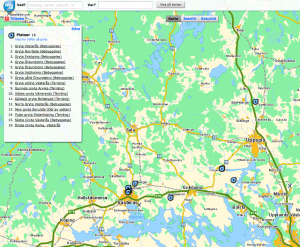So, where do you start if you want to know more about your Scandinavian roots? You perhaps know of a Swedish ancestor in your family and wanna know more? This is how you should proceed:
1 Talk to people. Theres nothing that beats first hand information f its available. Write everything down. Ask people who knows stuff to write down all they know about their family, names, dates, stories, occupations, events and so on. They might have photos and things thats more important than anything else. If you don’t have any living relatives from Sweden or anyone who met them alive, then you can skip this part and move to the next. But not otherwise. Even if you are eager to go digital there is nothing in geneaology that beats the feeling of seeing an ancestor on photo for the first time for example. But of course, you can always go back to this step. Sometimes people start to remember if you provide them information. Things they heard when they were young.
2 Search American resources. Try searching them at places like Ellis Island, where many Scandinavian immigrants arrived in the 1800s. Some of them also arrived in Canada and came from there to USA. Some information, but not much, can be found freely on Canada here. Trace their life in the US. Look through American records like this one. Search the white pages. Google away. But always remember that records might be faulty for a number of reasons (page on that coming shortly, and you should really check it out before going any further) and not finding anything doesn’t necessary mean that they don’t exist.
3 Lost in translation. When you actually have a name of a Swedish ancestor you are ready to search Swedish records. But, you should know something about the problems with Swedish-English translations before reading further. You can read more about it here (page coming soon), but in short the name written down on the immigration card or used by your ancestor when living and dying in America, and perhaps your name today, isnt necessarily the name he or she used in Sweden. Here is an example: My great grandfather August Alexander Svensson became August Alexander Swanson when he came to America. This was a common practice, to “americanize” the name. Most often just the family name (surname), but sometimes the full name . Svensson became Svensen, Swansen and Swanson for example and when the full name changed people called Johan Johansson became John Johnson and so on. You really should have this in mind all the time. When looking at American family trees I often see names that are typically americanized in the Swedish ones going back to Sweden, making research here troublesome or even impossible. And sometimes the name change wasn’t made by the immigrant, but by his descendants later on. You should really know that some of the immigrants had no sentimental feelings at all about their native lands and did their best to forget and hide their roots to blend in. Like in all times, immigrants often want to blend in, to avoid negative treatment and so on. There are also many examples of names being written down by immigration officers, who really didn’t hear what people like August Alexander Svensson actually said. Making their names or place of birth become distorted. Good luck finding your roots if all you have is a misspelled name or place of birth. Then you really have to do some research in to Swedish names and places. And by all means, ask a Swede!
4 Swedish resources (part one). So you have the actual Swedish name of your Swedish ancestor? Well then its time to start searching. And one of the first places you should explore isn’t Swedish. The page Ancestry.com has an excellent collection of stuff worth exploring. They have many family trees and plenty of Swedish sources. I would argue that you, if you haven’t done this already, should google the name and see what you find. Loads of geneaology services online have trees that a search engine like google can look through. My favourite pages here are geneanet and familysearch.org. But there are plenty of personal webpages and communities. But remember, family trees on the net are NOT original sources. They are, at best, second hand sources from skilled genealogists. But often third, fourth or even more times copied information from less careful people. Information copied many times tend to grow in errors, and if one person makes one mistake, that error is soon spread across the net. Some people don’t like the internet at all as a resource because of this. I disagree, if used with a sceptical and prudent manner, the sources are excellent in many ways – at least at some times. If you don’t know were to start with a name, using google and exploring other peoples trees is a good start. Suddenly your ancestors name might just come up. Swedish geneaologists are often interested in exploring immigrants, and the same goes for ancestors in the USA today, so there is plenty of information on the net. A black belt in google will take you far.
5 Swedish sources (part two). One thing you can try as a black belt googler is to google is the family name plus the word “anbytarforum”. If th surname looks unusual, it might just be (unlike Swanson, which is very common). For example in my family tree we have the name Kemner. It is of german origin and a simple google gives you a lot of german, completely irrelevant hits. Adding the word “anbytarforum” after the name will make google look through anbytarforum, wich is a large and old community with lots of information on genealogy – especially more distinct family names. However, most stuff there are in Swedish, but google translate might help you enough. You CAN search directly on their webpage, but google is easier to use.
6 Swedish resources (part three). Sooner or later you want to dig in to the original sources – and that means Swedish church records (census, protocols, parish registers and so on) The real and reliable sources that only depends on your own skills and errors (well almost, some errors exist in these to, made by clergymen 100s of years ago, who simply wrote the name or date of something wrong.) This is, where the “real genealogy” begins some would argue. Im not one of those, but there is a point to this. In a scientific perspective, this is the original data, no interpretation between you and the data.
Note this: No original records are searchable for free in Sweden. They all cost money. Not much, but around 10 to 40 dollars a month. I would argue that the best one of them all is Arkiv Digital. They have modern color scanned high resolution images. The competitor, the older SVAR, which use old microfilms scanned in black and white, generally have less documents, and of poorer quality. These are the documents that ancestry.com also use in their archive. So when you need to get in to the original sources, use Arkiv Digital.
7 Software. Use any software you like to build and create a tree. I personally recommend ancestry.com. Theirs is easy to use, works on all computers, is powerful when needed and presents the data nicely. You can even get a long way in creating your family tree without using their software. Just create it online on their page. Thats what I do for the most parts. But DO use a computer. Papers and pens will soon become impossible to use, and it is so much easier to paste in photos, sources and other important stuff in a software, than on paper. I only use pen and paper when documenting difficult cases and problems. Arkiv Digital use a small app for its sources. Easily installed on your mac, windows or linux-machine. Much more on computer related stuff in posts to come.
8 Document EVERYTHING. I know, documenting stuff is boring. You just want to continue deeper and deeper in to the church records in stead. Not lose any speed! But believe me, you will regret it if you don’t. Back tracking a person is hard work without proper sources attached to the person in the tree. And by adding sources to every piece of data, the credibility of your tree grows. When was your ancestor married? 1892? Then give a line pointing to what parish, book and page that is on. Even better: Add a screen shot to the person with this info directly from the book. Arkiv Digital provides EXCELLENT screen shots, where the pictures are named as the proper source. If you don’t have any photo of the person, a screen shot is a good option some times (I sometimes use tombstones, maps for people who moved, symbols for unique persons and churches for priests). Besides, it makes your tree more interesting.
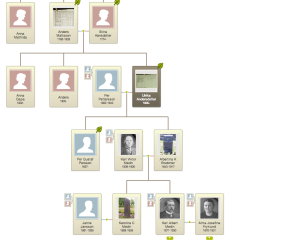
Screen shot from ancestry.com showing the general layout of a tree in ancestry.com. Used in stead of blanks or standard photos are screen shots from parish registers or even tombstones. Anything personal and logical is better than blanks in my opinion.
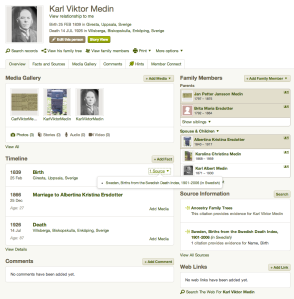
Screen shot of a selected person in ancestry.com. Note the use of sources directly to certain information (in this case, birth). It is very easy to add sources, photos and information.
9 Finally. You are an expert! No, just kidding. This was just the first part of a brief introduction. We still got loads more… Like actually reading a 17th century hand written piece of text in old Swedish and understanding the most commonly expressions, navigating your self around the parishes and named locations of Sweden. More on those things in posts to follow…

